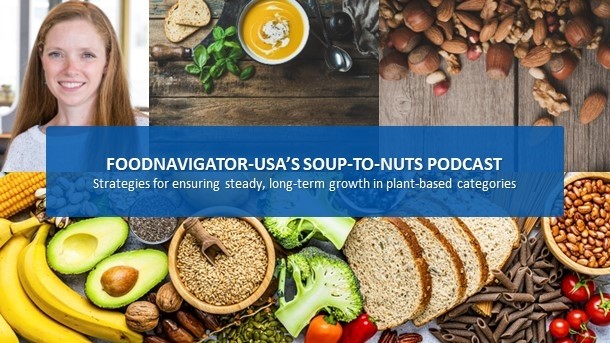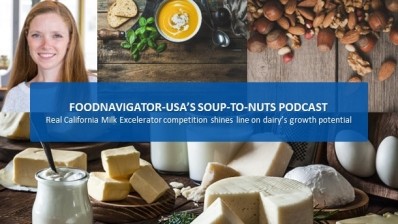Soup-To-Nuts Podcast: How plant-based players can ensure steady, long-term growth

According to data from SPINS and Numerator Insights presented this fall at Natural Products Expo East, pandemic adoption of the plant-based protein created short term hype with household penetration jumping from 16.4% in the first quarter of 2019 to 21.1% in the first quarter of 2020 followed by 22.3% and 23.5% in Q1 of each of the following years. In the back half of 2022, household penetration dropped sharply to about 20% in Q4. But the difference over three years remained strong with penetration up 41% from 2019. Looking forward, the data suggests the segment is back on track to produce long-term organic and steady growth of one to two percentage points per quarter from the fourth quarter of 2022 projected through the end of 2025.
During this time, sales of plant-based foods grew 6.6% to $8bn, capturing 4.5% of dollar and unit share, according to SPINS data, for a compound annual growth rate of 13% between 2019 and 2022. These numbers show that the 1% decline in plant-based meat in the US in 2022 over the prior year were more than offset by strong gains in other categories, including an 8.5% increase in plant-based milk, a 24% increase in creamer, a 15% increase in butter and a 13% increase in plant-based bars.
In this episode of FoodNavigator-USA’s Soup-to-Nuts podcast, Shannon Weis, the lead consultant and insights account manager for Kroger’s retail data science insights and retail media company 84.51˚ and Kathy Risch, senior vice president of consumer insights and trends at Acosta Group, share what is behind these numbers. They share what is driving sales of plant-based products, what challenges are holding the segment back and strategies for overcoming those hurdles for long-term growth.
[Editor’s note: Never miss an episode of FoodNavigator-USA’s Soup-to-Nuts podcast – subscribe today.]
The current landscape
To better understand how consumers’ approach to plant-based products are shifting and displacing animal-based foods Kroger’s 84.51˚ and the Plant-Based Foods Association teamed to conduct a migration analysis, the third wave of which was released at Natural Products Expo East.
Looking at the year-over-year shopping trends between 2019 and 2020, and again between 2020 to 2021 and 2021 to 2022, Weis explains the perceived drop off in plant-based sales post-pandemic is not as dire as some might believe and that the next era for plant-based foods is full of promise.
Rather, she says she see significant opportunity for plant-based brands and retailers to drive continued growth by better highlighting the benefits of plant-based that attracted consumers to the space in the first place.
These include personal health, environmental sustainability and animal welfare, which hold true across generations and income brackets.
Environmental sustainability, however, may take on a more important role going forward as it is more heavily influences younger shoppers, said Risch, noting that Gen Z has grown up with headlines about the impact of food on the planet and vice-versa so they are more educated and interested in supply chain integrity and ingredient sourcing.
Highlight product benefits to counter push-back on price
While many consumers want to buy products that are better for them, the planet and animals, they increasingly are price sensitive as higher prices from inflation linger in the grocery segment.
Research from Kroger and Acosta suggest brands and retailers can counter pricing pressure by leaning more heavily into positive attributes, such as sustainability, animal welfare and health benefits.
“If you take their attention off of the price point and better convey the benefits and total value proposition, you’re going to be in a much more advantaged position,” Risch said. “The more that brands can specifically communicate and retailers can communicate the value proposition of plant-based it is going to diminish the attention … on price valuation.”
She also noted animal-based product prices are extremely volatile and when they go up, there is more room for plant-based products to steal share.
Finally, she advised retailers to invest in plant-based private label offerings as a way to drive ongoing trial even in economically challenging periods.
Improve quality, drive innovation
According to Weis, the quality of plant-based products and concerns about ingredients and processing are also top challenges the industry must address.
“Customers are telling us that taste, texture and variety are still pain points in the plant-based foods industry. They are turned off by different additives or artificial ingredients and fillers. They have higher expectations are looking for cleaner label products,” she said.
Between experience and clean label, Risch argues brands should prioritizing tackling taste and texture because, she says, the debate about ‘over-processing’ is still at the industry level and is less prevalent among consumers, for now.
“Consumers are a bit simpler. They just want to make sure they understand what is in it, what are the ingredients and … if its healthy,” she explained.
What types of innovations in plant-based products to consumers want?
Risch noted the type of innovation consumers are most interested in depends in part on how heavily invested in plant-based eating they are. For example, she said, those who are flexitarian, vegetarian or vegan are looking for more options beyond the center of the plate, while those who are newer to the space will focus first on staples.
“When we look at those are already embedded like maybe already have been buying plant based alternative alternative milks or meats for a couple of years or more, they're going to be interested in things like chili or soup, or snacks as additional things that they would like to expand and see innovation in,” she said. “Whereas newer or prospective plant based users are going to gravitate to concepts that are milk or creamer or protein shake alternatives. So kind of in that dairy space of the which is a comfortable space to expand into plant base, but also pizza interestingly.”
Expanding access in store and online will drive sales
Limited access to plant-based products is another significant challenge which brand and retailers must work together to address with better in-store signage and broader selection both at retail and online.
Risch notes improved signage in stores will also help reassure consumers who are concerned about how plant-based products are made or who are unclear about how to use or prepare plant-based products.
Weis said she sees significant potential to educate consumers about, boost access to and drive sales of plant-based products through ecommerce, noting that “digital really helps level the playing field for the industry.”
To better understand how consumers search for plant-based foods online and how digital could support the industry, Kroger’s 84.51˚ and the Plant-Based Foods Association measured ecommerce behavior across nine plant-based categories and corresponding animal-based products for 12 weeks withing 1.4 million households.
Weis said the research revealed many consumers search for plant-based products online by category, and that they variations on spelling and base ingredients matter. For example, she said, seven of the top 10 searches for plant-based products were for milks with different attributes and spellings, such as oat milk and oatmilk.
Consumers also tended to describe the type of plant-based product they wanted by how they would use it such as searching for tofu for smoothies or baking.
The diversity of the terms, associated descriptions and even spelling variations used to find plant-based products reinforce the key takeaways for growing the plant-based segment, including as Weis and Risch noted cohesive messaging and education about how to prepare and use plant-based products and increased access to and innovation around plant-based options.























